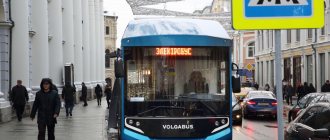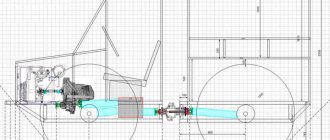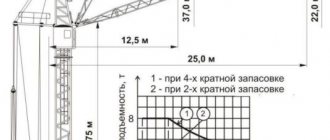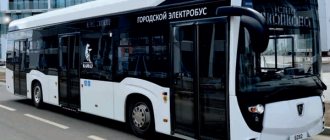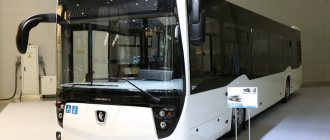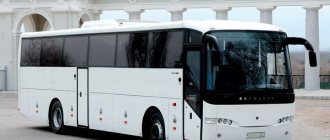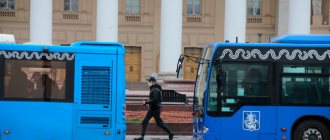The old-generation “horned” ones from Moscow’s 6th trolleybus fleet, which began operating in the summer of 1962, were evicted, completely giving the site to their ambitious grandchildren—electric buses. There are 200 of them registered here, one hundred each of LIAZ-6274 and KAMAZ-6282.
An electric bus is an exotic thing on a global scale. Moscow was not only one of the first to put them into operation, but also became a leader in the number of operating machines (the number reached the fourth hundred). Only China has more units per metropolis.
The electric bus has its own front mask. Therefore, not everyone will determine that the body used is from a diesel LIAZ-5292. KAMAZ also has unification, but in the opposite direction: first they developed a body for an electric vehicle, then they began to use it for diesel and gas versions.
The electric bus has its own front mask. Therefore, not everyone will determine that the body used is from a diesel LIAZ-5292. KAMAZ also has unification, but in the opposite direction: first they developed a body for an electric vehicle, then they began to use it for diesel and gas versions.
That’s why in the park you more often come across people wearing jackets from the GAZ group (the Moscow region LIAZ belongs to it) and KAMAZ than from Mosgortrans. The factories have organized full-fledged on-site maintenance and repair offices for electric buses. Even to the aid of faulty cars, it is not a Mosgortrans technician who comes to the rescue, but a car in the manufacturer’s “livery”.
This approach can also be explained by the fact that electric buses in Moscow were launched in the “needed yesterday” mode. The machines, of course, passed both test operation and certification, however, by and large, they are a mystery to many. Not in terms of prospects, but they are clear: electric buses are the future. It's about exploitation.
LIAZ-6274 (right) and KAMAZ-6282 (left) are difficult to distinguish from each other from the front. Please note: there are no manufacturer emblems on the front, instead the Moscow Transport logo. By the way, the tires also bear the Mosgortrans brand.
LIAZ-6274 (right) and KAMAZ-6282 (left) are difficult to distinguish from each other from the front. Please note: there are no manufacturer emblems on the front, instead the Moscow Transport logo. By the way, the tires also bear the Mosgortrans brand.
Life source
Take, for example, the replacement of the traction lithium titanate battery planned at the age of seven. In theory, its manufacturer, the Chinese Microwast, guarantees such a service life. And according to estimates, the batteries should last for seven years. With four charges per day, the declared 15,000 charge-discharge cycles will ensure operation for ten years.
But there are no seven-year-old electric buses in the world yet to rely on practical experience, and therefore we have to trust calculations on paper. In particular, no one undertakes to predict how the capacity will sag over the years and how many times a day a machine that is no longer new will have to be connected to the network.
The Microwast battery used, according to representatives of the GAZ group, is the optimal solution in terms of quality and characteristics. And yet its cost is scary. With the price of an electric bus at 32–34 million rubles, the battery costs about 9.5 million. Almost a third! Moscow, when drawing up a contract for electric buses, reserved battery replacement for itself. When the deadline comes, the city will decide for itself what to install.
In theory, a sound decision. It is now unknown what prices and technologies will be in a few years. Battery disposal, by the way, is also the responsibility of the city, but there is no infrastructure for it yet.
The batteries are located on the roof. If “green” cars weren’t distinguished by their design, they would be indistinguishable from regular ones: methane versions have the same “growth” on the roof, with cylinders hidden in it. True, the mass at the “back of the neck” of an electric bus is larger - 1.8–2.0 tons. But given the speed and manner of movement of a city car, this is not critical. Is that the load on the front axle in running order is slightly greater. By the way, the plant uses the same axles on all cars: diesel, methane, electric. And the maximum permissible weight is also the same - 18,000 kg. But the loaded load of the electric bus is noticeably greater than that of vehicles with internal combustion engines: 12,220 kg versus 10,500 kg.
LiAZ-6274 (2nd generation)
In February 2022, tests began on another electric bus, the LiAZ-6274, but this time of the second generation. The electric bus began running along the M2 route (Fili metro station - Kitay-Gorod metro station), connecting the western regions with the interchange hub on Slavyanskaya Square.
Photo: portal Moscow 24/Alexander Avilov
The electric bus was also produced on the basis of the low-floor LiAZ-5292 bus. It was distinguished by high mobility and environmental friendliness. It was equipped with 27 seats and could accommodate up to 90 passengers in total. Maximum speed – 80 km/h.
Three times a day the car had to be recharged using fast charging – for 10–20 minutes. Its battery life is 7–10 years, and the mileage without recharging depends on the load, traffic jams, and environmental conditions. At maximum load, the speed of the electric bus is up to 70 km/h. Testing of the machine has already been completed.
Diet
Moscow has opted for electric buses with frequent ultra-fast charging at terminal stations via a pantograph on the roof. The battery capacity is relatively small - 77 kWh. For comparison: the compact Nissan Leaf is entitled to 40 kWh, and premium passenger electric cars are charged 80–100 kWh.
And here is a heavy bus. According to the official technical specifications, LIAZ travels up to 59 km on one charge. In austerity mode it can reach 70 km. But the declared mileage is enough to make a full circle on the route and charge at the end. Since January, electric buses have been operating on a night route, the circle of which is about 48 km. Due to the absence of traffic jams and a small number of passengers, by the end of the circle there is sometimes 50% energy remaining!
To be on the safe side, on some routes they installed charging stations right along the route. The car can be charged without disembarking passengers - it’s safe. Taking into account the fact that in six to nine minutes the battery is filled by 50%, and charging on the way is necessary only to reach the end, the delay will only be a couple of minutes.
Ultra-fast 300-kilowatt charging stations are also supplied by the electric bus manufacturer. Liazovskaya and Kamazovskaya (pictured) are slightly different in appearance, but vehicles of both brands can be connected to them. With a current of up to 500 A, the battery is charged 50% in 6–9 minutes through a pantograph on the roof, and fully charged in 16–21 minutes (depending on the current supplied by the network).
Ultra-fast 300-kilowatt charging stations are also supplied by the electric bus manufacturer. Liazovskaya and Kamazovskaya (pictured) are slightly different in appearance, but vehicles of both brands can be connected to them. With a current of up to 500 A, the battery is charged 50% in 6–9 minutes through a pantograph on the roof, and fully charged in 16–21 minutes (depending on the current supplied by the network).
You can also charge “wired”. A fast station (150 kW, 200 A) will replenish energy in an hour or two, a 380 V network (11 kW, 20 A) - in 4-6 hours. For night mode it will do, but on the route such delays cannot be allowed.
When the energy reserve drops to 20%, the electronics warns the driver about this. There are two alternatives: continue driving in normal mode or turn on economical mode if the range before charging may not be enough. In the second case, the automation begins to disable individual systems, starting with the least valuable ones.
Criticism of Moscow electric buses
KamAZ and LiAZ electric buses have passed the stage of eliminating “childhood diseases” and are actively used in passenger traffic. But they are criticized. Firstly, at a cost that is 3 times higher than the cost of a regular diesel bus of equal capacity. Secondly, due to the need to spend time on charging, which is carried out during the day at the final stations of the route and increases the downtime of this vehicle. And thirdly, due to the presence of a stinking diesel interior heater with a 70-liter diesel tank - which in cold winter destroys the entire environmental effect of switching vehicles to electric power. And finally, since Moscow is supplied with electricity from thermal power plants, fuel still has to be burned to charge the batteries.
So it turns out that with the most advanced technologies and branded suppliers, there is complete damage to the budget and nature. Exactly as we warned in our article: Ecology and economics of electric vehicles: costs
Bright future
Moscow buys electric buses under a so-called “life cycle contract”: the manufacturer is paid not only for the vehicles themselves, but also for their maintenance throughout their entire service life. It lasts 15 years, which is twice as long as a bus lasts (in Moscow - seven years). The latter are written off without major repairs, but for the electric bus it was laid down in the middle of its life cycle. Although the body of the electric LIAZ is the same as that of the diesel one, with a declared service life of 12 years.
The driver's workplace reveals the electrical essence of the car only through a different combination of instruments. Among the indicators there is an alarm for breakdown of electrical insulation.
The driver's workplace reveals the electrical essence of the car only through a different combination of instruments. Among the indicators there is an alarm for breakdown of electrical insulation.
Whether it will be necessary to keep electric buses in service for a decade and a half, whether they will be produced for that long - no one knows yet. There are calculations, but they are theoretical, based on the experience of operating electric buses in other cities. But the road situation there is different, and the electric buses are different. In 2022, 300 “green” cars went on line in Moscow. A tender for 300 units has already been awarded for 2020. Perhaps there will be another contract.
In the front part of the cabin, the electric bus and the bus differ only in the finishing. An abundance of LCD panels is the standard for metropolitan transport. By the way, a pair of similar machines are being tested in Vladivostok and Tyumen. Cities received them in the “Moscow” configuration.
In the front part of the cabin, the electric bus and the bus differ only in the finishing. An abundance of LCD panels is the standard for metropolitan transport. By the way, a pair of similar machines are being tested in Vladivostok and Tyumen. Cities received them in the “Moscow” configuration.
From 2022, Moscow will stop purchasing diesel buses. But this does not mean a complete transition to electric buses: it is understood that methane models will remain in supply. Firstly, the production of electric versions is not yet so widespread. Secondly, in a year the entire city cannot be covered with the appropriate infrastructure for recharging cars. Now it is in the northeast and a little in the center of the capital. There is only one full-fledged electric bus fleet; another site partially works with them. And in total there are 25 of them in Moscow and Zelenograd! Thirdly, it is necessary to retrain all drivers. You can’t just transfer from a trolleybus or a bus to an electric bus.
So the capital’s transition to “electricity” will continue for many years. By the way, the GAZ group does not stop at one model. Electric buses of small and especially large classes are being prepared for production - Vector Next, made at PAZ, and "accordion" - at LIAZ.
And many promising technologies that improve safety and comfort will be introduced primarily on models with electric drive.
Trolleybus with Vitovt Max Duo diesel generator
Almost a year later, another model was launched in the capital. It was not an ordinary electric bus, but a duobus, which combined the functionality of a trolleybus and a bus. In July 2016, a Belarusian trolleybus with a Vitovt Max Duo diesel generator entered route “B” on the Garden Ring.
Photo: press service of Mosgortrans
The duobus was almost 19 m long and could accommodate 153 passengers. The cabin seats 38, has reclining seats and a retractable mechanical wheelchair ramp, as well as USB and 220-volt sockets for charging phones and laptops. In addition, the car was equipped with an air conditioning system, satellite navigation, CCTV cameras and a CAN system for diagnostics.
The traction motor allowed it to travel at speeds of up to 60 km/h. At the same time, the diesel generator not only moved the duobus, but also generated electricity for the traction electric motor. In this mode, Vitovt Max Duo could accelerate to 50 km/h.
There were no turnstiles in the trolleybus interior; you could enter through all doors. To pay for travel, validators were installed near each door. In addition, during stops the trolleybus tilted to make it easier for passengers to get on and off.
After test rides along the Garden Ring, the electric bus entered route “T25” - from Budyonny Avenue to Lubyanka Square. From the final stop “Prospekt Budyonny” to the Garden Ring, it traveled like a regular trolleybus - under wires, and along Pokrovka and Maroseyka - with the booms lowered, using the engine. After the tests, the duobus was also removed from the route.
Down with the horned ones!
The days of the Moscow trolleybus are numbered. He will not receive any development. Although, it probably won’t disappear completely, and some isolated routes with “horned animals” will remain. In defense of this type of transport, a whole movement was organized in the city, simultaneously criticizing electric buses with or without reason.
I am ready to agree with only one argument - the high price. Instead of one electric bus, you can buy two trolleybuses or 2.5 buses. The battery alone is not much cheaper than the entire bus. However, the tram is even more expensive, and it is protected no worse than the “horned ones” (almost sure that they are the same people).
Don’t forget that for now, battery-powered cars are exotic in any form. If they become truly widespread, they will become cheaper. And in order for them to be produced in large numbers, someone must ensure demand. If not Moscow, then who can do this in Russia?
Otherwise, the electric bus wins. The main thing is that it doesn't need wires. This includes improving the appearance of the city and the ability to flexibly rearrange the route network. The need for the latter is colossal. The launch of the MCC and MCD, the emergence of new microdistricts require changes that are easiest to implement with rolling stock not tied to wires or rails.
In addition, the contact network in the capital is badly worn out and requires expensive major repairs. Therefore, it was not taken into account when choosing the type of electric buses for Moscow. If the wires were in good condition, they could be left somewhere and used for recharging through the pantograph on the go.
The capital's electric bus: it can travel 59 km. But it normal
Story
The first electric bus was made in London in 1886. It could travel at an average speed of 11.2 kilometers per hour, and in 1907 a regular electric bus service was introduced between Victoria Station and Liverpool Street. The electric batteries allowed it to travel up to 40 miles without recharging, which was enough for four flights between final stops. After the morning shift, the electric bus went to the garage, where mechanics replaced the discharged batteries with new ones.
Clean and quiet electric buses have been popular with tourists and Londoners. At the peak of its success, in late 1908, there were about 20 electric buses running around England. Shortly afterwards an additional route to Kilburn was opened. But in 1910, the company servicing electric buses went bankrupt, and the rolling stock was sold or dismantled for spare parts.
China
Photo: AP/Reed Saxon
The largest fleet of electric buses transports passengers in the Middle Kingdom. The most popular electric bus in China today is the BYD K7. Eight-meter, 23-seater, equipped with in-wheel motors of our own design and LiFePO4 batteries. These batteries provide a range of up to 240 kilometers on a single charge.
One of the first cities where all buses were switched to electric traction was Shenzhen in China, where more than 16 thousand city electric buses move along the streets. For them, 510 standard charging stations and about eight thousand mini-charging installations were built in the city. In total, there are more than 200 thousand electric buses in China that transport passengers in dozens of cities: Guangzhou, Hong Kong, Shenzhen, Dongguan, Foshan, Zhongshan, Jiangmen, Zhuhai, Huizhou, Zhaoqing and Macau and others.
